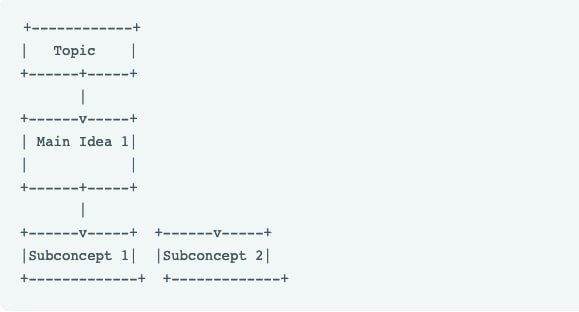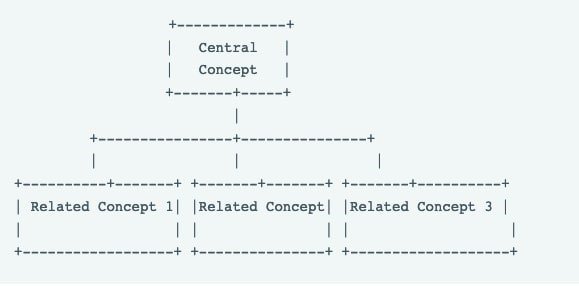What is a Literature Map?
A literature map is a visual representation that organizes, connects, and structures existing literature on a specific topic. Think of it as a mind map for research: it helps identify relationships between sources, find gaps in knowledge, and establish a deeper understanding of a field.
Table Of Content
- What is a Literature Map?
- Why is it Important?
- Types of Literature Maps
- Visual Literature Maps
- Text-based Literature Maps
- Key Tools for Literature Mapping
- Literature Mapping vs. Traditional Literature Review
- When to Use a Literature Map
- Research
- Writing
- Content Creation
- Strategic Planning
- Knowledge Management
- Examples of Literature Maps
- 1- Concept Map
- 2- Mind Map
- 3- Cluster Map
- 4- Timeline Map
- FAQ
- 1. What is the main purpose of a literature map?
- 2. Can a literature map replace a traditional literature review?
- 3. How do I choose the best type of literature map?
- 4. Is literature mapping difficult to learn?
- 5. What is Litmaps?
- 6. Do I need special software for literature mapping?
In essence, it’s:
- A tool for visually organizing research
- A way to see how ideas and studies link together
- An outline of connections across a topic
Why is it Important?
Imagine trying to read hundreds of papers without a clear sense of where they intersect. Literature maps guide you through the maze of information, showing how research flows and evolves. They’re especially useful for complex subjects with lots of subtopics, like psychology, environmental science, or history.
Types of Literature Maps
Literature maps can take on various formats, both visual and text-based, depending on the purpose and preferences of the researcher or writer. Here are some common types:
Visual Literature Maps
- Concept Maps: These are hierarchical diagrams that represent relationships between concepts using nodes and links. Concept maps are effective for organizing and visualizing complex ideas.
- Mind Maps: Similar to concept maps, mind maps are radial diagrams with a central topic branching out into subtopics and details. They are useful for brainstorming and capturing thoughts in a non-linear fashion.
- Flowcharts: Flowcharts use symbols and arrows to depict the sequence of steps or the flow of a process. They can be helpful in mapping out the progression of research or the structure of a literary work.
- Timelines: Timelines are visual representations of events or ideas arranged chronologically. They can be useful for mapping the development of a research area or the evolution of a literary movement.
Text-based Literature Maps
- Outlines: Outlines are hierarchical structures that organize information using headings and subheadings. They can be used to map out the structure of a research paper or a literary analysis.
- Matrices: Matrices are tables that organize information based on two or more dimensions. They can be helpful for comparing and contrasting different aspects of research or literary works.
- Annotated Bibliographies: Annotated bibliographies are lists of sources with brief summaries or evaluations. They can serve as a literature map by providing an overview of the relevant literature in a particular field.
- Literature Reviews: Literature reviews are comprehensive summaries and analyses of existing research on a particular topic. They can be considered a detailed form of a literature map, synthesizing and mapping the current state of knowledge in a field.
Both visual and text-based literature maps can be effective tools for organizing and understanding complex information. The choice of format often depends on personal preferences, the nature of the material being mapped, and the intended purpose of the literature map.
Key Tools for Literature Mapping
Today’s literature mapping is simplified by a variety of tools designed to visualize research data. Here are some of the top tools:
| Tool | Description |
|---|---|
| Litmaps | Combines research and citation mapping with live updates on new studies. |
| MindMeister | Allows for mind-mapping research, ideal for conceptual literature maps. |
| CitNetExplorer | Focuses on citation mapping, tracking influential studies and scholars. |
| VOSviewer | Analyzes bibliometric data to visualize research networks. |
Literature Mapping vs. Traditional Literature Review
Wondering why you might choose literature mapping over traditional literature reviews? Here’s a comparison:
| Aspect | Traditional Literature Review | Literature Mapping |
|---|---|---|
| Time-Intensive | Yes, can be long and detailed | Faster due to visualization |
| Complexity | Often text-heavy and complex | Simplifies data into maps |
| Ease of Identifying Gaps | Difficult without in-depth reading | Clearer due to visual structure |
| Connection Visualization | Minimal to none | Strong with clear links |
When to Use a Literature Map
A literature map can be a valuable tool in various scenarios, including:
Research
- When conducting a literature review for a research project, thesis, or dissertation
- To identify gaps, trends, and connections within a specific field of study
- To organize and synthesize existing knowledge on a topic
Writing
- When planning and outlining a book, article, or other written work
- To visualize the relationships between different ideas, concepts, and sources
- To ensure comprehensive coverage of a subject matter
Content Creation
- When developing educational materials, training programs, or course curricula
- To map out the flow and structure of content for better organization
- To identify areas that require additional resources or information
Strategic Planning
- When formulating strategies, policies, or initiatives in various sectors
- To understand the current landscape and existing literature related to the focus area
- To identify potential opportunities, challenges, and areas for further exploration
Knowledge Management
- When curating and organizing information within an organization or field
- To create a visual representation of the existing knowledge base
- To facilitate knowledge sharing and collaboration among teams or researchers
Examples of Literature Maps
Literature maps can take many visual forms depending on the field and purpose. Here are some examples:
1- Concept Map
A concept map displays ideas and concepts linked by words or phrases explaining the relationships between them. This map type works well for overviewing a topic or theory.

2- Mind Map
A mind map resembles a radial tree with branches stemming from a central node or topic. Useful for brainstorming or visualizing hierarchies.

3- Cluster Map
A cluster map groups related ideas around a central concept using circles or boxes. Great for exploring relationships.

4- Timeline Map
A timeline map arranges sources, events, or ideas chronologically along a linear path, helping visualize progressions over time.

These are just a few examples – literature maps can be customized in creative ways to best represent the relationships and flow of information for the given subject matter.
FAQ
1. What is the main purpose of a literature map?
A literature map visually organizes research within a field, helping to identify patterns, gaps, and connections between studies.
2. Can a literature map replace a traditional literature review?
Not entirely. While literature maps provide a quicker way to see research connections, a traditional literature review offers in-depth analysis and context.
3. How do I choose the best type of literature map?
Consider your research goals. Use thematic maps for topic overviews, citation maps for tracking influential studies, and conceptual maps for exploring theories.
4. Is literature mapping difficult to learn?
No! With tools like Litmaps and MindMeister, literature mapping is intuitive and user-friendly, even for beginners.
5. What is Litmaps?
Litmaps is an online tool for literature mapping, which provides live updates on new research within a user’s specified areas of interest.
6. Do I need special software for literature mapping?
No special software is required, although tools like Litmaps or VOSviewer can make mapping easier and more dynamic.








No Comment! Be the first one.